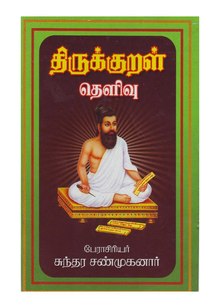
Back তিরুক্কুরাল Bengali/Bangla Tirukkural German Tirukkural Spanish تیروکورال Persian Tirukkuṟaḷ French तिरुक्कुरल Hindi ティルックラル Japanese തിരുക്കുറൾ Malayalam तिरुक्कुरल् NEW Tirukkural Polish
 A typical published original Tamil version of the work | |
| Author | Valluvar |
|---|---|
| Original title | திருக்குறள் |
| Working title | Kural |
| Translator | See list of translations |
| Language | Old Tamil |
| Series | Eighteen Lesser Texts |
| Subject | |
| Genre | Poetry |
| Set in | Probably Post-Sangam era (c. 500 CE or earlier) |
Publication date | 1812 (first known printed edition, older palm-leaf manuscripts exist)[3] |
| Publication place | India |
Published in English | 1794 |
Original text | திருக்குறள் at Tamil Wikisource |
| Translation | Tirukkuṟaḷ at Wikisource |
The Tirukkuṟaḷ (Tamil: திருக்குறள், lit. 'sacred verses'), or shortly the Kural (Tamil: குறள்), is a classic Tamil language text on commoner's morality consisting of 1,330 short couplets, or kurals, of seven words each.[4] The text is divided into three books with aphoristic teachings on virtue (aram), wealth (porul) and love (inbam), respectively.[1][5][6] It is widely acknowledged for its universality and secular nature.[7][8] Its authorship is traditionally attributed to Valluvar, also known in full as Thiruvalluvar. The text has been dated variously from 300 BCE to 5th century CE. The traditional accounts describe it as the last work of the third Sangam, but linguistic analysis suggests a later date of 450 to 500 CE and that it was composed after the Sangam period.[9]
The Kural text is among the earliest systems of Indian epistemology and metaphysics. The work is traditionally praised with epithets and alternative titles, including "the Tamil Veda" and "the Divine Book."[10][11] Written on the ideas of ahimsa,[12][13][14][15][16] it emphasizes non-violence and moral vegetarianism as virtues for an individual.[17][18][19][20][21][a] In addition, it highlights virtues such as truthfulness, self-restraint, gratitude, hospitality, kindness, goodness of spouse, duty, giving, and so forth,[22] besides covering a wide range of social and political topics such as king, ministers, taxes, justice, forts, war, greatness of army and soldier's honor, death sentence for the wicked, agriculture, education, and abstinence from alcohol and intoxicants.[23][24][25] It also includes chapters on friendship, love, sexual unions, and domestic life.[22][26] The text effectively denounced previously held misbeliefs that were common during the Sangam era and permanently redefined the cultural values of the Tamil land.[27]
The Kural has influenced scholars and leaders across the ethical, social, political, economic, religious, philosophical, and spiritual spheres over its history.[28] These include Ilango Adigal, Kambar, Leo Tolstoy, Mahatma Gandhi, Albert Schweitzer, Ramalinga Swamigal, V. O. Chidambaram Pillai, Karl Graul, George Uglow Pope, Alexander Piatigorsky, and Yu Hsi. The work remains the most translated, the most cited, and the most citable of Tamil literary works.[29] The text has been translated into at least 57 Indian and non-Indian languages, making it one of the most translated ancient works. Ever since it came to print for the first time in 1812, the Kural text has never been out of print.[30] The Kural is considered a masterpiece and one of the most important texts of the Tamil literature.[31] Its author is venerated for his selection of virtues found in the known literature and presenting them in a manner that is considered common and acceptable to all.[32] The Tamil people and the government of Tamil Nadu have long celebrated and upheld the text with reverence.[19]
- ^ a b Sundaram 1990, pp. 7–16.
- ^ Zvelebil 1973, pp. 156–168.
- ^ Kovaimani and Nagarajan, 2013, p. 115.
- ^ Pillai, 1994.
- ^ Blackburn 2000, pp. 449–482.
- ^ Zvelebil 1973, pp. 157–158.
- ^ Lal 1992, pp. 4333–4334, 4341.
- ^ Holmström, Krishnaswamy, and Srilata, 2009, p. 5.
- ^ Zvelebil 1975, p. 124.
- ^ Zvelebil 1973, p. 156.
- ^ Cutler, 1992.
- ^ Chakravarthy Nainar, 1953.
- ^ Krishna, 2017.
- ^ Thani Nayagam, 1971, p. 252.
- ^ Sanjeevi, 2006, p. 84.
- ^ Krishnamoorthy, 2004, pp. 206–208.
- ^ Dharani 2018, p. 101.
- ^ Das 1997, pp. 11–12.
- ^ a b Zvelebil 1973, pp. 156–171.
- ^ Sundaram 1990, p. 13.
- ^ a b Zvelebil 1973, pp. 160–163.
- ^ Hikosaka & Samuel 1990, p. 200.
- ^ Ananthanathan, 1994, pp. 151–154.
- ^ Kaushik Roy 2012, pp. 151–154.
- ^ Lal 1992, pp. 4333–4334.
- ^ Thamizhannal, 2004, p. 146.
- ^ Sundaramurthi, 2000, p. 624.
- ^ Maharajan, 2017, p. 19.
- ^ Kovaimani and Nagarajan, 2013, p. 29.
- ^ Chellammal, 2015, p. 119.